Ludwigsburg is a sizeable town famous for its Baroque palace complex just to the north of Stuttgart, the capital of Baden-Württemberg.
The main town is located just to the west of the Neckar river, although the suburbs and several walks through the vineyards do reach the riverbank.
Although the town attracts many tourists to the famous residential palace and gardens, it is also home to a number of engineering, banking and insurance companies, as well as a prestigious film school, the Filmakademie Baden-Württemberg.
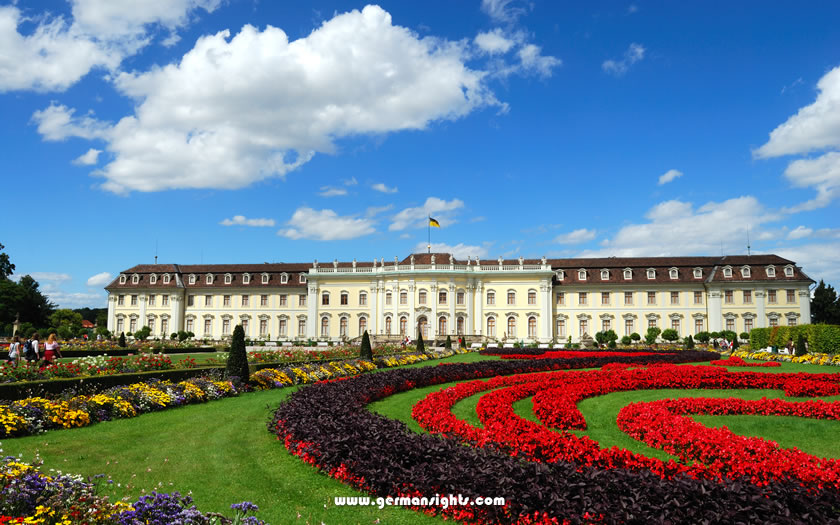
View of the Ludwigsburg Palace and Gardens
Although many tourists visit Ludwigsburg Residential Palace on a day trip from Stuttgart, the town makes a good base for exploring the sights around the state capital and other attractions to the north. The train station near the city centre offers regular services into Stuttgart and north to Heilbronn and Heidelberg.
Stuttgart airport is easily the closest and most convenient option for those wanting to travel to Ludwigsburg.
Distance to Stuttgart Airport: 26km
Distance to Karlsruhe-Baden-Baden Airport: 96km
Distance to Memmingen (Allgäu) Airport: 146km
Distance to Frankfurt Airport: 158km
Distance to Friedrichshafen (Bodensee) Airport: 160km
The smaller airports at Baden-Baden and Memmingen may have options for those looking for cheaper airlines but, apart from the airport at Stuttgart, the international and national flight choices at Frankfurt are likely to offer most choice.
Ludwigsburg is on the S-Bahn regional services from the main Stuttgart train station and also offers services north to Heilbronn and Heidelberg. The train station is located within easy walking distance of the residential centre with plenty of accommodation nearby.
Ludwigsburg is situated just off the A81 motorway which links Stuttgart and Würzburg.
Much of the accommodation in Ludwigsburg is conveniently clustered around the railway station. The area behind the train station has been redeveloped into a centre for accommodation and restaurants, while the town side of the station is only a few minutes' walk from the centre.
One notable exception is the Schlosshotel Monrepos, which is located on a golf course next to the former royal hunting lodge on a small lake on the outskirts of Ludwigsburg.
If you know when you are planning to go but haven't decided on accommodation, then use the map below to get an idea of which properties are available and to compare prices during the period you wish to travel.
Enter your proposed dates and use the '+' to zoom in on a location and reveal more properties. Click on the price above a property to see more information.
(Please note that this selection will also include some guesthouses, pensions and self-catering apartments for those who are interested in that form of accommodation!)
Alternatively, if you would like a list of properties available on your proposed dates of travel, use the search box below to find accommodation:
Archaeologists have discovered remains of prehistoric settlements in the Ludwigsburg region, although the city itself only really dates back to the early 18th century.
It was built to the west of the Ludwigsburg Residential Palace by Duke Eberhard Ludwig of Württemberg as a planned community according to the designs of the palace architect Donato Giuseppe Frisoni.
The idea was that wide avenues and low residential buildings would form a geometric pattern around the market square (Marktplatz).
The Duke aimed to use the new settlement as a new court (and location for him to spend time with his mistress) and offered various inducements for those wishing to move there from Stuttgart: freedom from taxes for a certain period; freedom of religious expression; and free land and building materials.
However, he also wanted 'ideal' inhabitants and so prospective citizens were required to meet certain income levels.
In 1718 the capital of Württemberg was moved from Stuttgart to Ludwigsburg and all government staff were ordered to relocate.
Nonetheless, by the time of Duke Eberhard Ludwig's death in 1733 Ludwigsburg still only had half the population of Stuttgart.
Under his descendants, the capital of Württemberg swapped back and forth between Stuttgart and Ludwigsburg before settling in Stuttgart under Duke Carl Eugen.
The final switch to Stuttgart in 1775 came as the result of a political power struggle and Ludwigsburg rapidly declined in importance (getting the derisive nickname of 'Grasburg' as the buildings and avenues became overgrown).
Ludwigsburg regained part of its former prominence when the Residential Palace was declared a 'summer residence' by Duke Frederick II of Württemberg at the end of the 18th century.
Between 1798 and 1804 he had the palace gardens redesigned into an English landscape garden as part of the then popular 'Classicism'.
Ludwigsburg had long been a garrison town and, allied with the French under Napoleon, thousands of Württembergers marched off on the Russian campaign - with only around 500 soldiers returning. The city however retained a large military presence during the following decades.
The religious freedom offered originally in Ludwigsburg had led to a sizeable Jewish population in the city. However the synagogue was destroyed during the 1938 pogrom - the original site now has a memorial of suitcases represented those murdered during the Nazi period.
The city suffered relatively lightly during the fighting at the end of World War II and a large US Army barracks was stationed there until the 1990s.
The Ludwigsburg Residential Palace is one of the largest baroque palace complexes in Europe. It covers nearly 80 acres and includes more than 450 rooms.
The construction of the palace, sometimes called the 'Swabian Versailles', started in 1704 before that of the main town of Ludwigsburg as a retreat for the ruler of Württemberg.
Duke Eberhard Ludwig felt restricted by his original capital Stuttgart and the partial destruction of the New Palace there allowed him the opportunity to build a new court out in the countryside.
It was no coincidence that this also allowed him to live with his mistress, Wilhelmine von Grävenitz, rather than his wife, Johanna Elisabeth von Baden-Durlach.
Duke Eberhard never actually got to see the completed palace - he died a few months before the last rooms in the final building (the Neuer Hauptbau) were finished in 1733.
Although the palace is mainly known as a complex of buildings in the Baroque style, it also incorporates Rococo and Neoclassical elements added by Eberhard's descendants over the following decades.
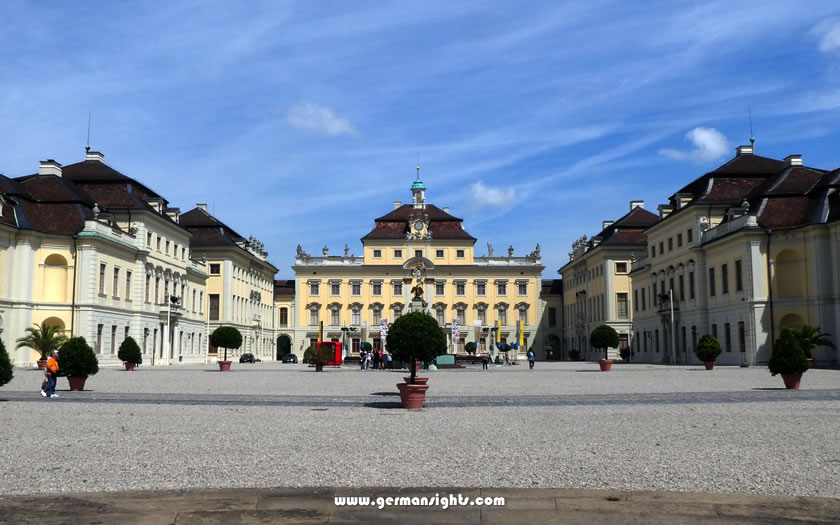
The interior grounds of Ludwigsburg Residential Palace
Nowadays, the palace is a major tourist attraction in the Stuttgart region, attracting hundreds of thousands of visitors each year.
It is possible to book a standard tour of the palace as well as visit one of the four museums in the complex.
It is also the site of the annual Ludwigsburg Festival, a major cultural event at the start of each summer.
The main palace buildings are surrounded by formal gardens at the front and other garden areas at the rear, including a fairytale garden for children, which are collectively known as 'Blühendes Barock' ('Blooming Baroque'). A separate entry fee is charged for a ticket to the garden areas.
A bridge leads over the busy road at the back of Ludwigsburg Palace to Favorite Park, a large parkland area with wildlife and paths leading through to the small lake palace of Monrepos.
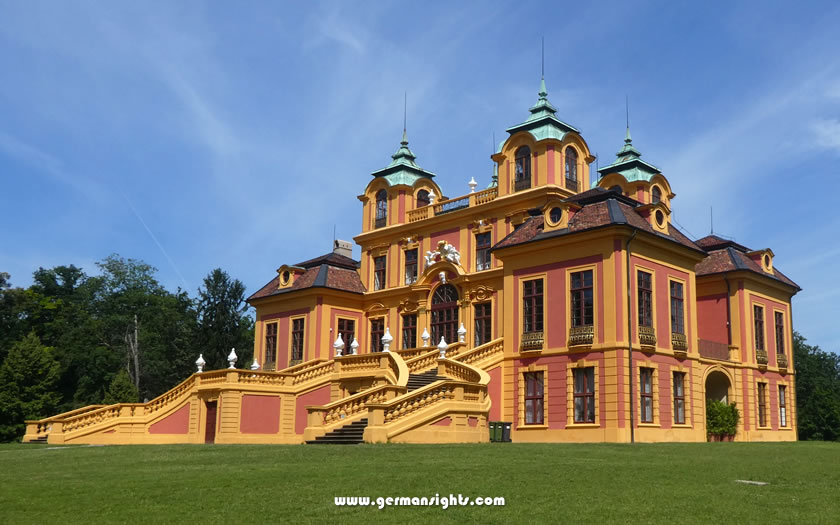
Schloss Favorite in Ludwigsburg
Schloss Favorite, near the entrance to the park, was originally built in the early 18th century and was designed as a small 'hunting castle' (or rather a large country villa) with access to the woods and fields of the surrounding countryside.
Part of the attraction of this type of building for rulers was to have an escape from the official duties of the court.
Monrepos Palace is another hunting lodge around three kilometres from Schloss Favorite through the parkland of Ludwigsburg. This lodge was built on a small lake a century after the other two palaces and still belongs to the former royal family of Württemberg.
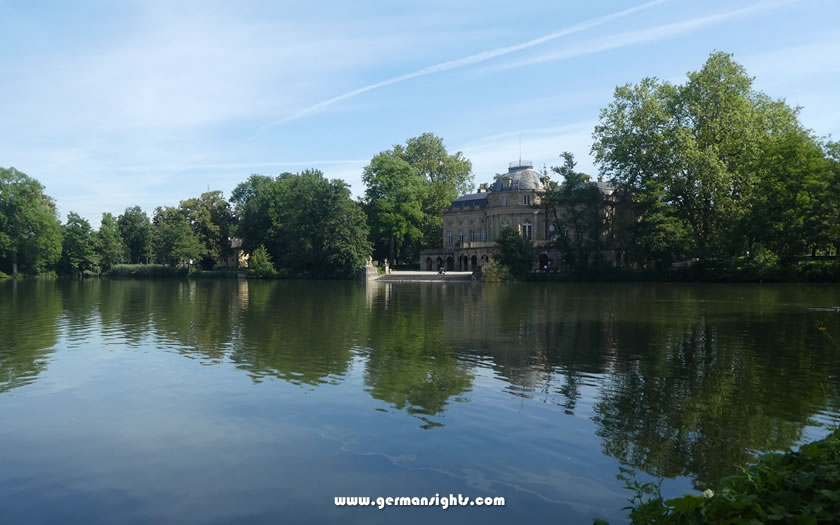
Monrepos Palace viewed from across the lake
The route through Favorite Park to Schloss Monrepos is a favourite outing for local joggers, walkers and cyclists. Paddle boats can be hired to explore the small lake near Monrepos.
Ludwigsburg Palace Website: www.schloss-ludwigsburg.de
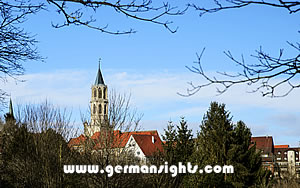
Rottweil is characterised by its medieval architecture and is renowned for being one of the oldest towns in the region. The city is noted for its centuries-old annual carnival tradition, Fasnet. It's also widely recognized for giving its name to the well-known breed, the Rottweiler dog.
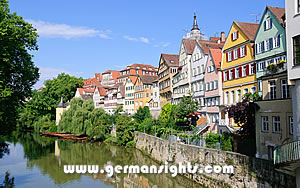
Tübingen dates back to the Middle Ages and is distinguished by its well-preserved old town featuring half-timbered houses and cobbled streets. Tübingen is also home to one of Europe's oldest universities, the Eberhard Karls University, established in 1477.
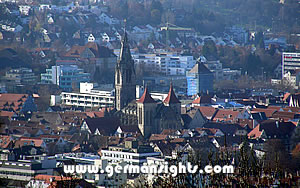
Reutlingen can boast several historical architectural sites from the Middle Ages, including its iconic town church, Marienkirche, and the imposing Tübinger Tor. It is located at the foot of the Swabian Jura and offers a blend of urban life and natural beauty.
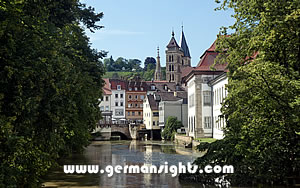
Esslingen is famous for its well-preserved medieval old town. The town is characterised by its half-timbered houses, majestic towers and the impressive Esslingen Castle. Once an influential imperial city in the Middle Ages, it is now known for its automotive and engineering industries.
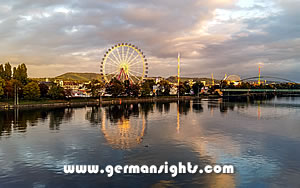
Stuttgart is a dynamic and diverse city in the heart of Baden-Württemberg. Founded in the 10th century, Stuttgart has transformed itself from a historic city into an automotive powerhouse, famously home to world-renowned car manufacturers such as Mercedes-Benz and Porsche.
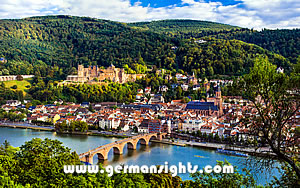
Heidelberg is home to Germany's oldest university, Ruprecht Karl University, founded in 1386. The city is synonymous with the iconic Heidelberg Castle, a mix of styles from Gothic to Renaissance, perched on a hill and overlooking the city and river below.
Ludwigsburg tourist office is located on the edge of the central pedestrian area. It is closed on Mondays and public holidays and has shorter opening times on Sundays.
Tourist Office: visit.ludwigsburg.de